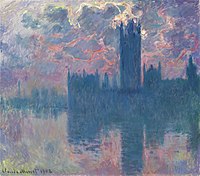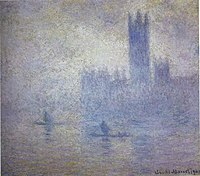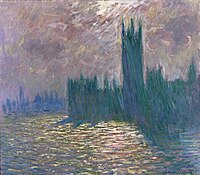Claude Monet painted several series of nearly 100 impressionist oil paintings of different views of the Thames River in the autumn of 1899 and the early months of 1900 and 1901 during stays in London. One of these series consists of views of the Palace of Westminster, home of the British Parliament, and he began the first of these paintings at about 15.45 on 13 February 1900. All of the series' paintings share the same viewpoint from Monet's window or a terrace at St Thomas' Hospital overlooking the Thames and the approximate canvas size of 81 cm × 92 cm (32 in × 36 3/8 in). They are, however, painted during different times of the day and weather conditions.
By the time of the Houses of Parliament series, Monet had abandoned his earlier practice of completing a painting on the spot in front of the motif. He carried on refining the images back home in Giverny, France, and sent to London for photographs to help in this. This caused some adverse reaction, but Monet's reply was that his means of creating a work was his own business and it was up to the viewer to judge the final result.
Gallery
Some of the 19 known paintings in the Houses of Parliament series:
-
 Houses of Parliament, London, 1900–1901 The Art Institute of Chicago
Houses of Parliament, London, 1900–1901 The Art Institute of Chicago
-
 Parlement, coucher du soleil (sunset), 1902, private collection
Parlement, coucher du soleil (sunset), 1902, private collection
-
 Le Parlement, Effet de Brouillard, 1903, Museum of Fine Arts (St. Petersburg, Florida)
Le Parlement, Effet de Brouillard, 1903, Museum of Fine Arts (St. Petersburg, Florida)
-
 Houses of Parliament in the Fog, 1903, High Museum of Art
Houses of Parliament in the Fog, 1903, High Museum of Art
-
 The Houses of Parliament, Seagulls, 1903, Princeton University Art Museum
The Houses of Parliament, Seagulls, 1903, Princeton University Art Museum
-
 The Houses of Parliament, Sunset, 1903, National Gallery of Art Washington, DC.
The Houses of Parliament, Sunset, 1903, National Gallery of Art Washington, DC.
-
 Houses of Parliament Sunlight Effect (Le Parlement effet de soleil), 1903, Brooklyn Museum
Houses of Parliament Sunlight Effect (Le Parlement effet de soleil), 1903, Brooklyn Museum
-
 The Houses of Parliament (Effect of Fog), 1903–1904, Metropolitan Museum of Art
The Houses of Parliament (Effect of Fog), 1903–1904, Metropolitan Museum of Art
-
 Trouée de soleil dans le brouillard (Sun Breaking Through the Fog) Houses of Parliament, 1904. London, Sun Breaking Through the Fog, 1904 Musée d'Orsay, Paris
Trouée de soleil dans le brouillard (Sun Breaking Through the Fog) Houses of Parliament, 1904. London, Sun Breaking Through the Fog, 1904 Musée d'Orsay, Paris
-
 Houses of Parliament, stormy sky, 1904, Palais des Beaux-Arts de Lille, Lille, France
Houses of Parliament, stormy sky, 1904, Palais des Beaux-Arts de Lille, Lille, France
-
 Houses of Parliament, London, ca. 1904, Kunsthaus Zürich
Houses of Parliament, London, ca. 1904, Kunsthaus Zürich
-
Seagulls, the River Thames and the Houses of Parliament, 1904, Pushkin Museum
-
 Houses of Parliament, London, Musée Marmottan Monet, 1905
Houses of Parliament, London, Musée Marmottan Monet, 1905
-
 Le Parlement, soleil couchant (Houses of Parliament, Sunset), 1900-1903, Hasso Plattner Collection
Le Parlement, soleil couchant (Houses of Parliament, Sunset), 1900-1903, Hasso Plattner Collection
-
 Houses of Parliament, London, Kunstmuseen Krefeld, 1904
Houses of Parliament, London, Kunstmuseen Krefeld, 1904
-
 Modern view of the Houses of Parliament at dusk in an approximately identical angle. The paintings were framed to exclusively depict the leftmost half of the building, with Victoria Tower as the focal point.
Modern view of the Houses of Parliament at dusk in an approximately identical angle. The paintings were framed to exclusively depict the leftmost half of the building, with Victoria Tower as the focal point.
Context

Under exile during the Franco-Prussian War, Monet travelled to London for the first time in 1870. Monet became enthralled with the city, and vowed to return to it someday. Monet's fascination with London lay primarily in its fogs, a byproduct of the Industrial Revolution. But writers hypothesize that Monet was also inspired by contemporaries J. M. W. Turner and James Abbott McNeill Whistler, who were similarly fascinated by London's atmosphere and atmospheric effects in general. Thus, in 1899, Monet returned to London and rented a room in the Savoy Hotel, which offered an extensive viewpoint from which to begin his series of the city.
Between 1899 and 1905 Monet periodically travelled to London to paint. In addition to the Houses of Parliament paintings, Monet created other paintings of the city's sights, including the Charing Cross Bridge series and Waterloo Bridge series. While Monet began all of the paintings in London, he completed many of them in his studio in Giverny. As a result, some critics question whether the paintings are completely accurate. On the other hand, analyses of solar positioning reported in 2006 show that Monet's paintings "contain elements of accurate observation and may potentially be considered as a proxy indicator for the Victorian smogs and atmospheric states they depict." A 2023 study shows that "stylistic changes from more figurative to impressionistic paintings by Turner and Monet over the 19th century strongly covary with increasing levels of air pollution. In particular, stylistic changes in their work toward hazier contours and a whiter color palette are consistent with the optical changes expected from higher atmospheric aerosol concentrations. These results indicate that Turner and Monet’s paintings capture elements of the atmospheric environmental transformation during the Industrial Revolution."
Public display
Impressionists in London
In 2018 the Tate Britain in London exhibited six paintings of the series, together in a single room, for the duration of a temporary exhibition titled Impressionists in London, French artists in exile (1870–1904), devoted to the temporary exile of French and impressionist artists in London during the Franco-Prussian War. This was a rare occurrence because no museum owns or exhibits more than two in a permanent collection.
The paintings were also shown at the Petit Palais when the temporary exhibition travelled from London to Paris.
The six paintings were the examples from the following collections:
- Art Institute of Chicago
- Brooklyn Museum
- Kaiser Wilhelm Museum
- Metropolitan Museum of Art
- Musée d'Orsay
- Museum of modern art André Malraux - MuMa
Monet & Architecture
Again in 2018 the National Gallery in London exhibited three paintings of the series, together in a single room, for the duration of a temporary exhibition titled Monet & Architecture, devoted to Claude Monet's use of architecture as a means to structure and enliven his art. This was a rare occurrence because no museum owns or exhibits more than two in a permanent collection.
The three paintings exhibited were the examples from the following collections:
See also
References
- "Claude Monet: The Houses of Parliament (Effect of Fog) (56.135.6) In Heilbrunn Timeline of Art History. New York: The Metropolitan Museum of Art, 2000–. (December 2010)".
- "Monet's London | the Credit Suisse Exhibition: Monet & Architecture | National Gallery". YouTube. 24 April 2018.
- "Monet, Claude: Houses of Parliament, London".
- Randerson, James (8 August 2006). "'Hospital view. Experts decipher where Monet was standing', James Randerson, Wednesday 9 August 2006, Guardian Unlimited". TheGuardian.com.
- "'Monet's view of London parliament for auction', Michael Parsons, 2 May 2015, The Irish Times". The Irish Times.
- "Houses of Parliament in the Fog". High Museum of Art. Retrieved 22 October 2023.
- "Brooklyn Museum". www.brooklynmuseum.org. Retrieved 22 October 2023.
- "Le Parlement de Londres / Peintures XVIe - XXIe siècles / Chefs-d'Œuvre / Collections - Palais des Beaux Arts de Lille". pba.lille.fr. Retrieved 22 October 2023.
- The Sun: Source of Light in Art. Edited by Michael Philipp, Ortrud Westheider, Daniel Zamani, Prestel, 2023, p. 228.
- "Sammlung". Krefeld (in German). 27 June 2023. Retrieved 22 October 2023.
- ^ House, John, 1945-2012. (1991). Monet. Monet, Claude, 1840-1926. (3rd ed.). London: Phaidon. ISBN 0-7148-2723-1. OCLC 28061909.
{{cite book}}: CS1 maint: multiple names: authors list (link) CS1 maint: numeric names: authors list (link) - Monet, Claude (1900–1901), Houses of Parliament, London, retrieved 22 October 2023
- ^ Khan, Soraya; Thornes, John E.; Baker, Jacob; Olson, Donald W.; Doescher, Russell L. (2010). "Monet at the Savoy". Area. 42 (2): 208–216. Bibcode:2010Area...42..208K. doi:10.1111/j.1475-4762.2009.00913.x. ISSN 1475-4762.
- House, John, 1945-2012. (1991). Monet. Monet, Claude, 1840–1926. (3rd ed.). London: Phaidon. ISBN 0-7148-2723-1. OCLC 28061909.
{{cite book}}: CS1 maint: multiple names: authors list (link) CS1 maint: numeric names: authors list (link) - Sweetman, John (23 May 2019). The Artist and the Bridge 1700–1920. doi:10.4324/9780429440083. ISBN 9780429440083. S2CID 241749768.
- ^ Baker, Jacob; Thornes, John E (8 December 2006). "Solar position within Monet's Houses of Parliament". Proceedings of the Royal Society A: Mathematical, Physical and Engineering Sciences. 462 (2076): 3775–3788. Bibcode:2006RSPSA.462.3775B. doi:10.1098/rspa.2006.1754. S2CID 129004829.
- https://www.pnas.org/doi/10.1073/pnas.2219118120 Individual paintings by artists including Vincent van Gogh and Edvard Munch have been shown to depict specific atmospheric phenomena, raising the question of whether longer-term environmental change influences stylistic trends in painting. Anthropogenic aerosol emissions increased to unprecedented levels during the 19th century as a consequence of the Industrial Revolution, particularly in Western European cities, leading to an optical environment having less contrast and more intensity. Here, we show that trends from more figurative to impressionistic representations in J.M.W. Turner and Claude Monet’s paintings in London and Paris over the 19th century accurately render physical changes in their local optical environment. In particular, we demonstrate that changes in local sulfur dioxide emissions are a highly statistically significant explanatory variable for trends in the contrast and intensity of Turner, Monet, and others’ works, including after controlling for time trends and subject matter. Industrialization altered the environmental context in which Turner and Monet painted, and our results indicate that their paintings capture changes in the optical environment associated with increasingly polluted atmospheres during the Industrial Revolution.
- Brown, Mark (18 July 2017). "Monet's UK parliament paintings to feature in Tate Britain exhibition". The Guardian. Retrieved 26 March 2018.
- Sooke, Alastair (30 October 2017). "Not very impressionistic, but beautiful all the same – Impressionists in London Tate Britain, review". The Daily Telegraph. Retrieved 26 March 2018.
- Palais, Petit (1 January 2018). "Impressionists in London". Petit Palais. Retrieved 25 May 2018.
- Krefeld, Kuntsmuseen (1 January 2018). "Art Before 1945". Kunstmuseen Krefeld. Retrieved 3 April 2018.
- "Monet & Architecture". National Gallery, London. April 2018. Archived from the original on 20 December 2018. Retrieved 20 December 2018.
- Cumming, Laura (8 April 2018). "Monet & Architecture". The Guardian. Retrieved 20 December 2018.
Further reading
- Baker, Jacob; Thornes, John E. (8 December 2006). "Solar Position within Monet's Houses of Parliament". Proceedings of the Royal Society A: Mathematical, Physical and Engineering Sciences. 462 (2076): 3775–3788. Bibcode:2006RSPSA.462.3775B. doi:10.1098/rspa.2006.1754. S2CID 129004829.